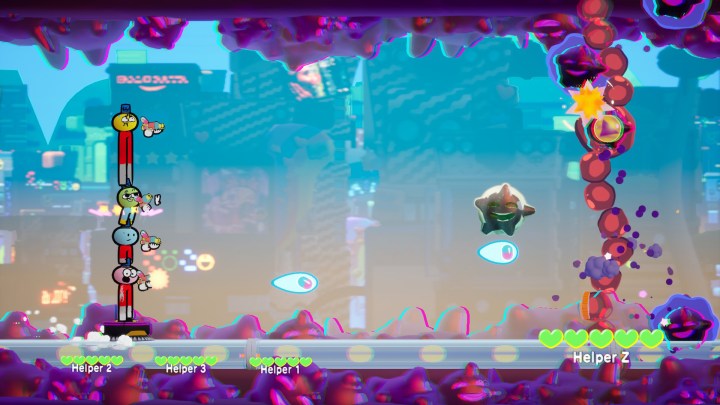Despite its small library of games, the Nintendo 64 has its fair share of hidden gems. That’s especially true of its multiplayer collection, which contains a host of bizarre and charming split-screen titles. Those kinds of local multiplayer experiences are harder to come by in the age of online play, but Glitch Busters: Stuck On You might just scratch that itch.
Developed by Toylogic, Glitch Busters is a colorful and very family-friendly shooter about little emojis blasting glitches inside of a computer world. I went hands-on with the title at Summer Game Fest and found it to be a promising multiplayer experience. That’s thanks to creative co-op systems that put team play front and center. The secret to its success? Magnets.
Stuck on you
In Glitch Busters, up to four players move through a colorful computer world inspired by the visual language of emojis (at one point, a giant barfing emoji started dropping purple sludge on my path). At a very basic level, it’s a third-person shooter where each player controls a pint-sized emoji face with magnets for legs. I spent my demo blasting colorful gunk and viruses while traversing a surreally constructed digital world.

Those magnet legs I mention aren’t just for show. They’re the key to the game’s creative co-op multiplayer. For one, I can press a button to magnetize to a teammate at any time. Doing so lets me skate around a stage and smash into enemies — a melee tackle that I can only perform with the help of a buddy. Beyond that, it’s just a useful tool that makes sure I’m always able to find my friends.
My favorite co-op hook, though, is that all four players can stand on top of one another to form a totem pole. At several points, I’d jump on the top of an emoji stack, safely shooting enemies as my teammates handled movement.
That system is key for building smart co-op puzzles too. In one stage, I jumped on a teammate’s head and he walked me over to a platform that neither of us could reach on my own. I expanded my magnet legs to give me extra height and then hopped up there. Doing so allowed me to toss some yellow items down to my pals to solve a puzzle below me. That little moment has me particularly excited about Glitch Busters‘ multiplayer potential, as it requires communication and teamwork to progress.

Like any good multiplayer game, there’s potential for trolling too. If a friend jumps on your head, you can toss them off at any time — a powerful tool I will absolutely misuse to annoy my pals. I especially like the game’s teamwide perk system. Whenever a team can get a buff, the screen goes to a quick team vote. Players have a few seconds to vote on which of two perks the team will get for the rest of the level, like extra health. Toylogic jokes that it’ll spark some heated debates between friends.
The developers tell me that the game was inspired by Nintendo 64 split-screen games and that definitely comes through in the game so far. Its wacky visual style and commitment to local co-op play (though it can be played solo and online too) remind me of renting random games I’d never heard of from Blockbuster for a sleepover with buds. With an eight-hour campaign and a few extra modes that let players create custom challenges, I could see rekindling that innocent childhood magic when it releases.
Glitch Busters: Stuck on You doesn’t have a release date yet, but it will launch for PC, PS4, PS5, and Nintendo Switch.
Editors' Recommendations
- Every summer 2023 gaming showcase: full schedule of live streams
- You have to try these two climbing game demos during Steam Next Fest
- We played Tribeca Fest’s 2023 game selections and walked away amazed
- After years of wishing, Persona games are coming to Nintendo Switch
- Here’s the full schedule of summer video game livestreams





